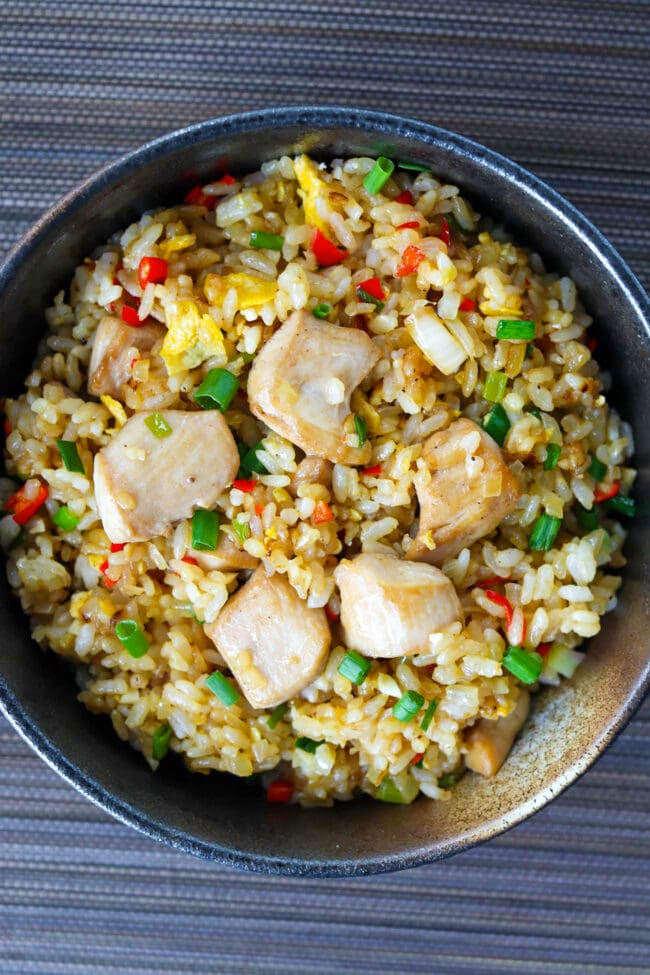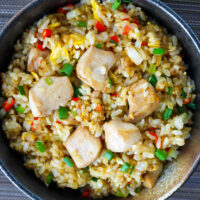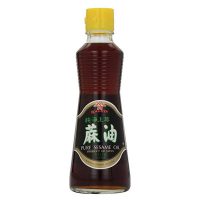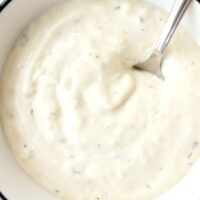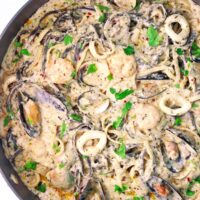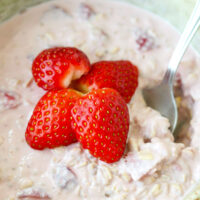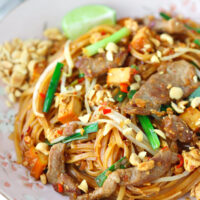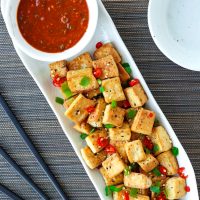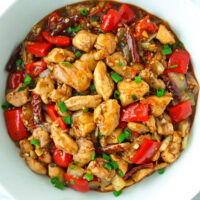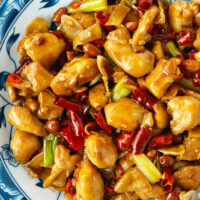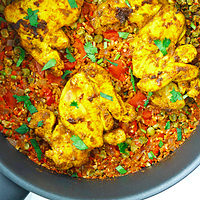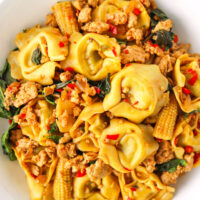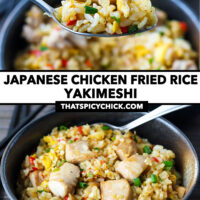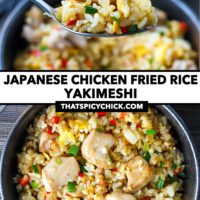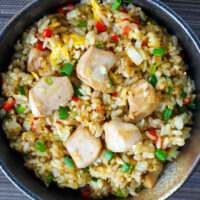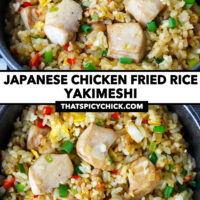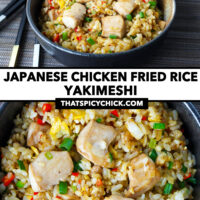Japanese Chicken Fried Rice (Yakimeshi)
This post contains affiliate links.
This Japanese Chicken Fried Rice is easy to make in one wok in under 30 minutes and full of delicious flavors! Juicy chicken pieces, scrambled egg, spring onion, rice, pepper and a savory sauce come together to make this tasty fried rice. Serve it as a side or main dish.
Fried rice has always been a favorite go-to dish of mine when a quick and easy dinner is needed and there’s leftover rice in the fridge. This Japanese Chicken Fried Rice (Yakimeshi) is full of savory and spicy flavors (though you can make it mild without the chilies) and super easy to cook in less than 30 minutes!
Being cooked in both oil and butter in a hot wok, the flavors and textures are outstanding and reminiscent of the fried rice I love to order at Teppanyaki restaurants.
What sets this fried rice apart from other Chinese and Japanese fried rice dishes is a secret ingredient – Japanese Kewpie Mayonnaise. Thanks to this trick I learned from Marion’s Kitchen and Chopstick Chronicles, mixing the rice with this mayonnaise allows each grain to separate from one another and fry individually to perfection in the pan.
While I’ve made this rice with chicken, egg, onion, and spring onion, you can customize it with any other proteins you like and veggies in your crisper drawer that need to be used up.
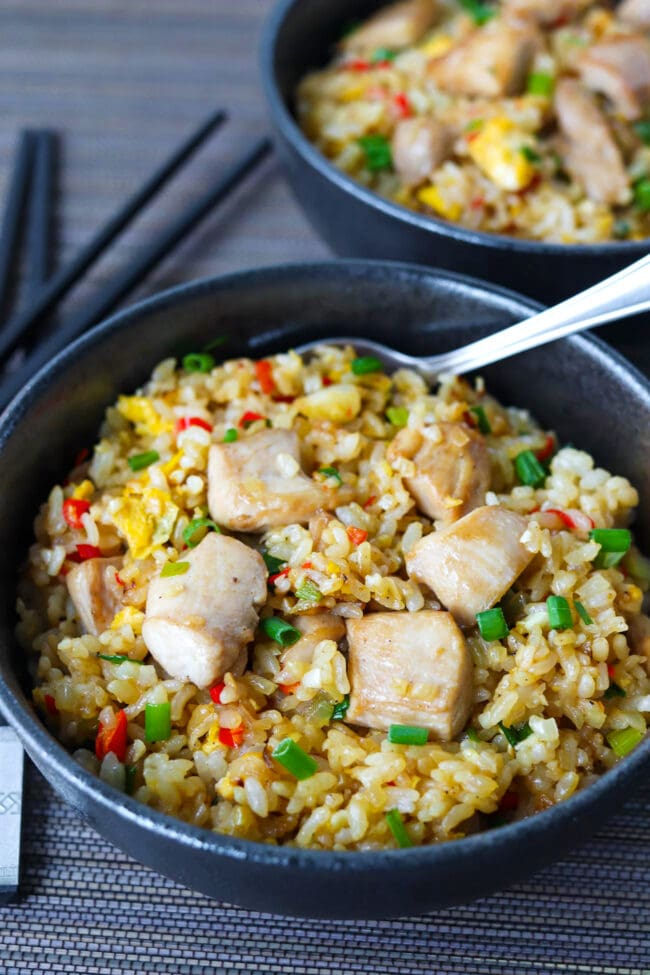
Why This Recipe Works
- Quick and easy! It’s ready in under 30 minutes and cooked in just one wok/pan.
- Perfect texture with separated rice grains. When Japanese Kewpie mayonnaise is mixed into the rice, it coats each grain with a thin layer of oil and keeps them separate from each other. This ensures that each grain fries and does not steam. The end result is a non-mushy fried rice.
- Customizable. You can switch up the protein and veggies based on your preference and what you have on hand.
- Delicious weeknight side or main. You can eat it as a side with other Asian or Chinese main dishes and sides. Or simply enjoy it as a main dish with some pickled red ginger on the side.
Ingredient Notes and Substitutes
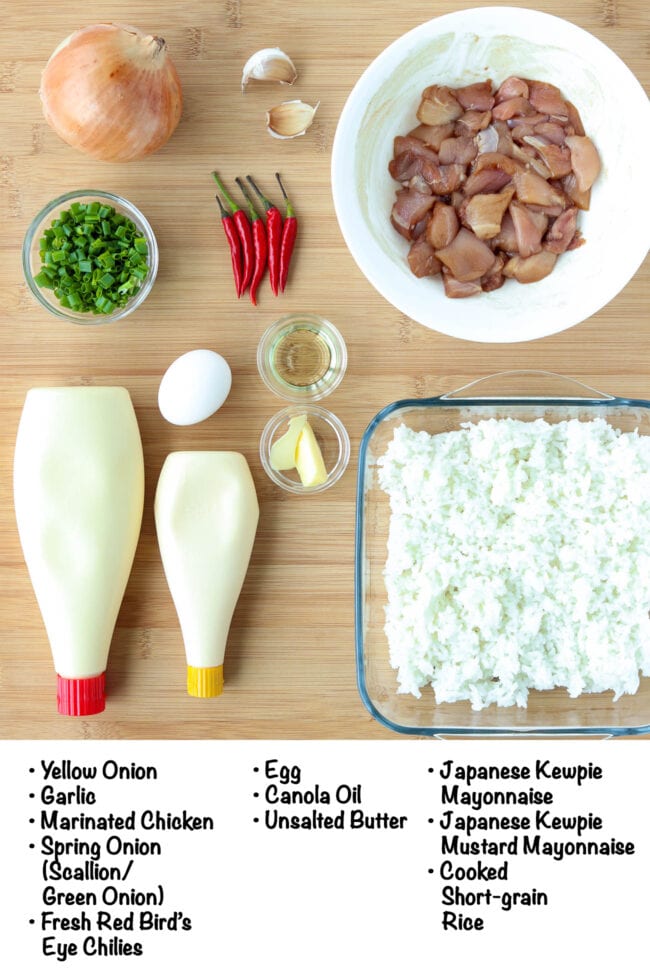
- Marinated Chicken: I used boneless and skinless chicken thighs and marinated the pieces with low sodium light soy sauce, ground white pepper, kosher salt, and sesame oil. (See ‘Variations’ section below for other protein ideas.)
- Fresh Bird’s Eye Red Chilies: Japanese cuisine is generally not spicy and chilies are not typically added to Japanese fried rice. I like the extra kick of heat, but you can leave them out if you prefer.
- Cooked Short-Grain White Rice: Yakimeshi is typically made with short-grain Japanese rice such as koshihikari rice. It is stickier and glossier than the long-grain rice used in Thai and Chinese cuisine (such as Thai Jasmine rice). It’s best to use 2-day old cold rice for this recipe but even 1-day old cold rice will work.
- Japanese Kewpie Mayonnaise: This particular mayonnaise is different from Western mayonnaise in that it is made with egg yolks only (no whites). It is richer in flavor with a hint of tang from vinegar on its own. However, the tang is not noticeable once the fried rice has been cooked. Its purpose is to create a thin coating of oil on each grain and separates them from one another. This in turn prevents the fried rice from becoming soggy or mushy. You can find it in Japanese and Asian supermarkets, or online.
- Japanese Kewpie Mustard Mayonnaise: This is another Japanese mayonnaise by the Kewpie brand and it has a slightly spicy mustard flavor. It is not always easily available outside of Asia but you can try finding it at a Japanese or Asian supermarket, or order it online. Alternatively, feel free to use more Japanese Kewpie mayonnaise in its place.
- Canola Oil: Feel free to use vegetable oil or any other neutral cooking oil with a high smoke point.
- Unsalted Butter: Japanese fried rice is often cooked in butter. I find using unsalted butter gives you more control over the salt levels.
- Egg: I used 1 egg here, but you can use 2 eggs if you like your fried rice with more egg.
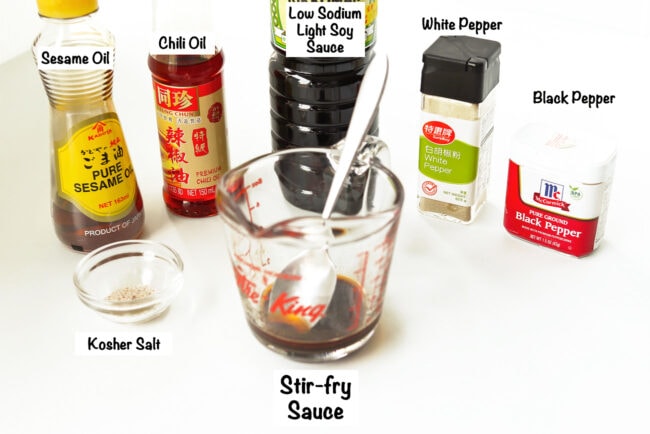
- Kosher Salt: Use half the amount if using iodized sea salt. Adjust quantity to taste.
- Ground White and Black Pepper: Using both white and black pepper gives this dish a nice peppery kick. Feel free to adjust to taste.
- Sesame Oil: Although not always used in Japanese fried rice, I love the toasted sesame flavor and aroma that it gives to the fried rice.
- Pure Chili Oil: This is a pure chili oil without any seeds or flakes. You can use a Chinese one or Japanese La-Yu by S&B brand. Leave it out or use less for a milder fried rice.
- Low Sodium Light Soy Sauce: Low sodium is best if you want to have more control over the salt levels. If using regular light soy sauce, use less.
Full ingredient list and amounts are in the recipe card below.
How to Make Japanese Chicken Fried Rice (Yakimeshi)
1. Mix the rice with the mayonnaise. Mix together the cooked rice with the Kewpie mayonnaise and mustard mayonnaise until mixed through and the grains are evenly coated and separated. Combine the chicken and marinade ingredients in a separate bowl. Whisk together all the sauce ingredients in a small measuring cup or bowl. Chop all the fresh ingredients and set everything by the side of your wok.
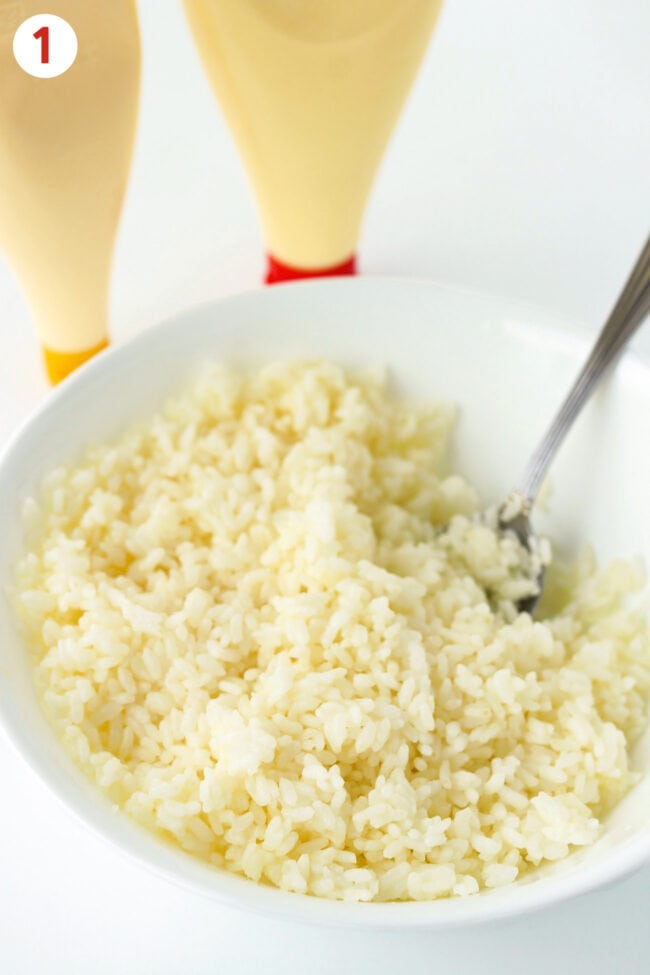
2. Cook the chicken. Add a little oil to a large wok or a large deep edged frying pan/skillet and cook the marinated chicken. Transfer to a clean bowl and set aside.
3. Stir-fry the onion and aromatics. Heat the unsalted butter and remaining oil in the wok and stir-fry the onion and spring onion white and light green parts until translucent. Add the garlic and chilies and stir-fry until fragrant.
4. Add the mayonnaise coated rice. Stir-fry to combine with everything.
5. Cook the egg. Push everything to the side of the wok and add a little oil if needed. Pour the egg in and allow to set for a few seconds, then scramble and toss to combine with the rice.
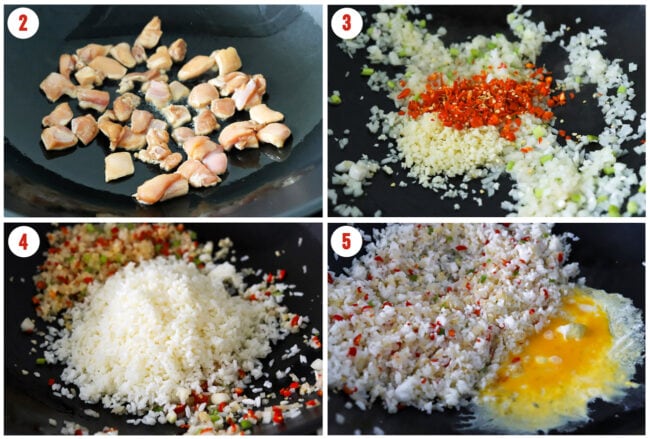
6. Add the chicken and sauce. Stir-fry until everything is coated well in the sauce.
7. Toss through the spring onion dark green parts. Switch off the heat.
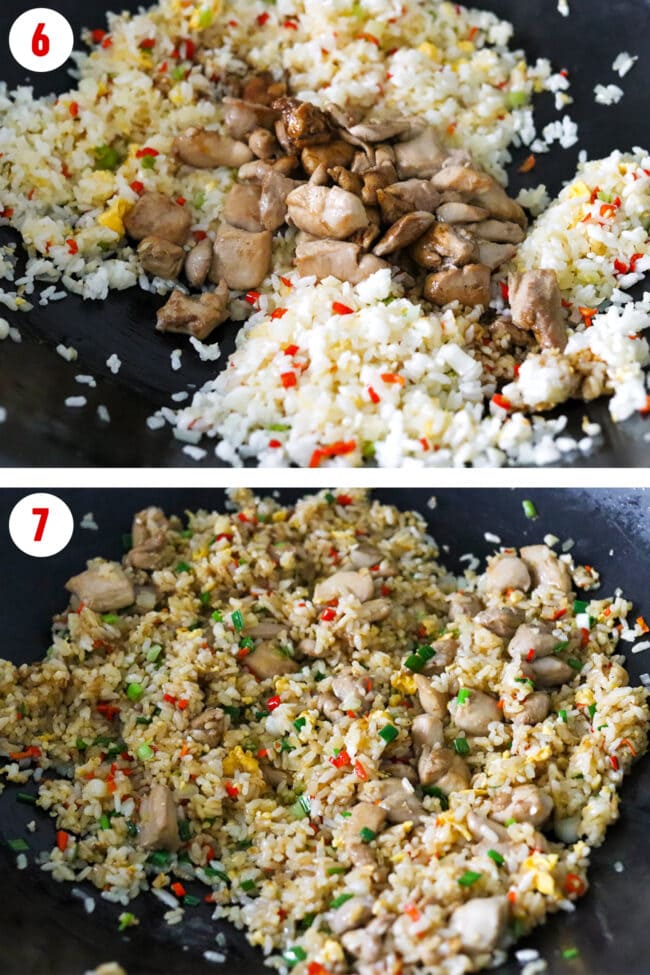
Serve! Transfer to a serving plate or divide evenly into bowls. Sprinkle with more spring onion dark green parts. You can serve it as a side with other Asian main dishes or as a main with Japanese pickled red ginger.
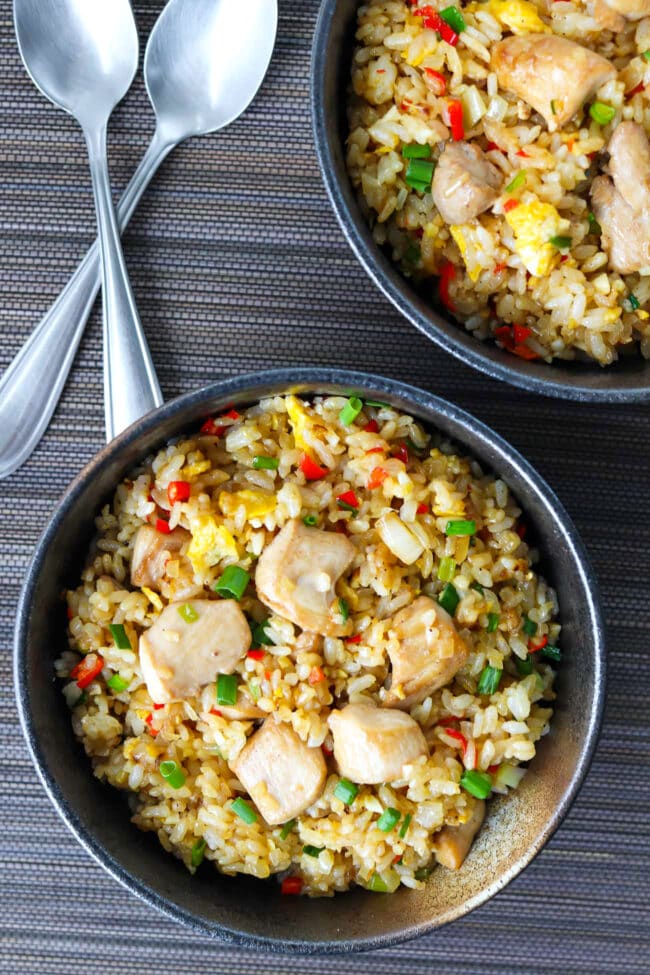
Full detailed instructions are in the recipe card below.
Cook’s Tips
- Use day old cold cooked short-grain rice. It’s even better if the rice is 2-days old as the grains will lose moisture from sitting in the fridge and won’t become mushy in the wok.
- Remove the rice from the fridge 20 minutes before you plan to cook. While cold rice is best for fried rice, it will be easier to mix with the mayonnaise and break apart in the wok if it is not straight out of the fridge.
- Use a large wok or a deep edged frying pan. This will ensure ample surface area to fry the rice. Overcrowding a small wok or skillet will result in a mushy fried rice.
- Omit the chilies and pure chili oil for a milder fried rice. Omit completely or use less based on your heat level preference.
FAQs
Japanese fried rice involves using extra fats and oils to be cooked perfectly. However, it can be incorporated in a well-balanced diet and is not unhealthy if eaten in moderation.
Yakimeshi and Chahan. Often, the two are used interchangeably to refer to Japanese fried rice. However, chahan is simpler in terms of the ingredients list and the eggs are cooked prior to adding the rice to the wok. For yakimeshi, the egg is cooked after the rice is in the wok.
The main difference is the type of rice used. Japanese fried rice is made with short-grain rice which is stickier in texture and glossier in appearance. Hence, Japanese fried rice is not as dry as Chinese fried rice, which is usually made with long-grain rice.
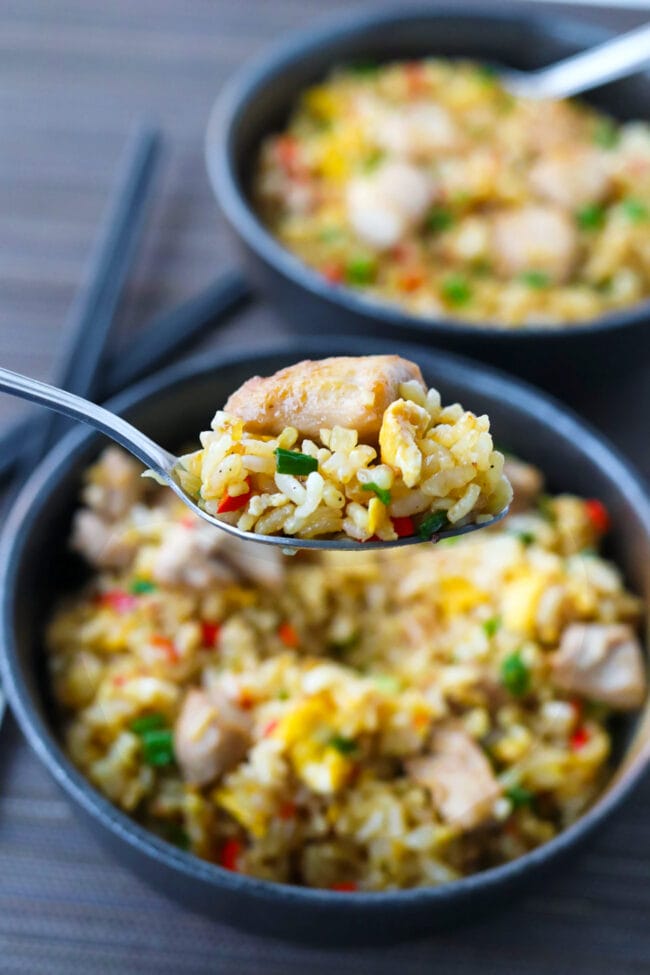
Variations
- Use a different protein. Use chopped Japanese char siu (barbeque pork), shrimp/prawns, pork belly, ham, spam, ground pork, salmon (try my Garlic Salmon Fried Rice) etc. You can also make a Japanese egg fried rice by using 2 eggs (for 3 cups cooked cold rice) and omitting other meats.
- Add/use different veggies. Green peas, carrots, zucchini, corn, green beans, edamame, etc.
- Use short-grain brown rice. This will boost the nutritional content and make it more wholesome.
- Keep the seasoning traditional. Traditional yakimeshi is seasoned with soy sauce, salt and pepper. If you’d like this fried rice to be more traditional, leave out the chili oil and sesame oil.
- Make it vegetarian/vegan. Omit the chicken to make it vegetarian and omit the egg as well to make it vegan.
- Make it gluten-free. Use a gluten-free light soy sauce (low sodium preferred) or tamari.
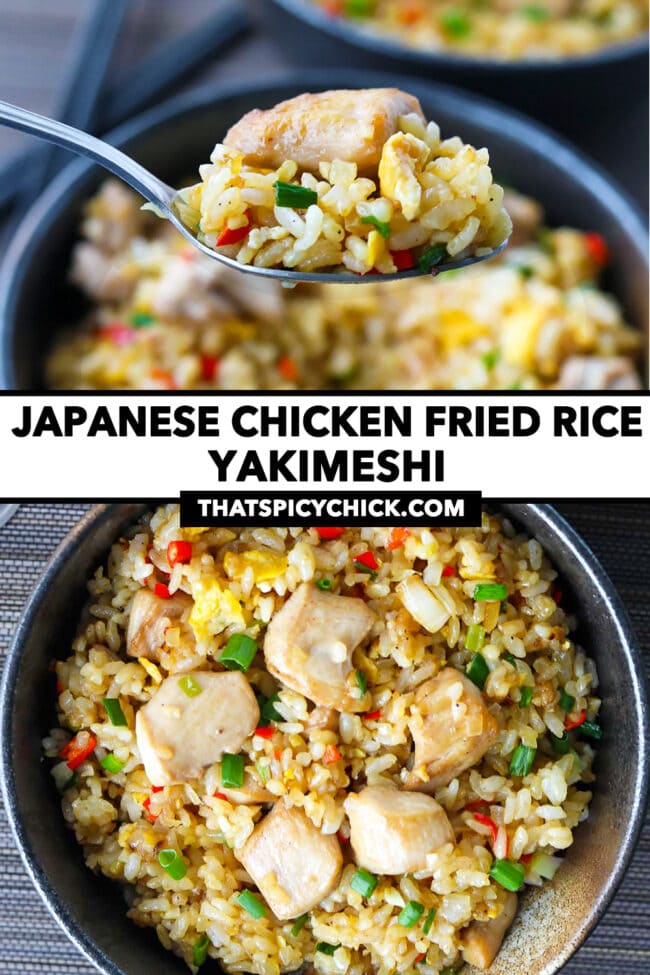
More Fried Rice
- Garlic Salmon Fried Rice
- Crispy Tofu Spicy Fried Rice
- XO Sauce Fried Rice
- Chili Garlic Chicken Fried Rice (Sichuan Yu Xiang style)
- Thai Red Curry Fried Rice
- Or browse the entire Fried Rice recipes collection.
More Japanese Recipes
- Japanese Pork Rice Bowl (Butadon)
- Japanese Curry Udon with Pork Belly
- Japanese Pork Belly Curry
- Spicy Miso Ramen with Chicken Meatballs
- Spicy Udon Noodle Soup with Chicken & Mushrooms
- Or browse the entire Japanese recipes collection.
MADE THIS RECIPE? If you make this recipe, leave a comment below and let me know how you liked it! Take a photo and tag it with @thatspicychick on Instagram and hashtag it #thatspicychick and I’ll be sure to share your masterpiece!
STAY CONNECTED! You can also follow me on Pinterest, Facebook or Instagram. Sign up for my email list to get my latest recipe in your inbox weekly!
PrintJapanese Chicken Fried Rice (Yakimeshi)
Juicy chicken pieces, egg, spring onion, rice, pepper and a savory sauce come together to make this Japanese Chicken Fried Rice! Ready in under 30 minutes and perfect as a side or main dish!
- Prep Time: 10
- Cook Time: 15
- Total Time: 25 minutes
- Yield: 6 1x
- Category: Side
- Method: Stir-fry
- Cuisine: Japanese
Ingredients
For the Chicken Marinade:
- 250 grams / 9 ounces Chicken Thighs, boneless, skinless – trimmed, cleaned, cut into bite-sized pieces
- 2 TSP Low Sodium Light Soy Sauce
- ¼ TSP ground White Pepper
- 1/8 TSP Kosher Salt
- ¼ TSP Sesame Oil
For the Sauce:
- ½ + 1/8 TSP Kosher Salt (note 1), to taste
- ¼ TSP ground White Pepper
- 1/8 TSP ground Black Pepper (black pepper powder)
- 1.5 TBLS Low Sodium Light Soy Sauce
- 1 TSP Sesame Oil
- 1 TSP Pure Chili Oil (optional – without seeds/flakes – note 2)
For the Fried Rice:
- 3 Spring Onion (Scallion/Green Onion) – finely chopped, light green and white parts separated from dark green parts
- ½ small Yellow Onion – finely chopped
- 5 Garlic cloves – finely chopped
- 2–10 fresh Red Chilies (optional – Bird’s Eye or any other small hot red chilies – note 2), to taste – finely chopped
- 3 cups cooked Short-Grain White Rice (such as Japanese Koshihikari rice, 2 day old cold rice works best – note 3) – chilled
- 1 TBLS Japanese Kewpie Mayonnaise (note 4)
- 1 TSP Japanese Kewpie Mustard Mayonnaise (note 5 – or use more Kewpie Japanese Mayonnaise)
- 1.5 TBLS + 1 TSP Canola Oil (or other neutral flavored oil with a high smoke point)
- ½ TBLS Unsalted Butter
- 1 large Egg – lightly beaten
Instructions
Prep:
- Marinate the chicken: Trim off excess fat from the chicken thighs and cut into bite-sized pieces. Add the chicken to a medium bowl, followed by the low sodium light soy sauce, ground white pepper, kosher salt and sesame oil. Mix well to coat, then set aside.
- Make the sauce: Whisk together the kosher salt, ground white pepper, ground black pepper, low sodium light soy sauce, sesame oil and chili oil (if using) in a small measuring glass or bowl until combined well.
- Prepare the fresh ingredients. Chop the spring onion (separate the white and light green parts from the dark green parts), yellow onion, garlic, fresh red chilies (if using) as indicated in the ‘Ingredients’ section. Crack the egg into a small bowl and beat lightly.
- Mix the rice with the mayonnaises: In a large bowl or dish, mix the cooked rice with Kewpie mayonnaise and spicy mustard mayonnaise (if using) until mixed through and the grains are evenly coated and separated.
For the Japanese Chicken Fried Rice:
- Cook the chicken: Heat 1 tablespoon canola oil in a large wok (or a large deep edged frying pan/skillet) over high heat. Add the marinated chicken and allow to sear for 30 seconds, then stir-fry for 1 minute until just cooked through. Transfer to a fine mesh strainer held above the wok, allowing any excess oil to drip back in. Place the strainer with the chicken over a clean bowl and set aside.
- Stir-fry the onion and aromatics: Add ½ tablespoon unsalted butter and ½ tablespoon canola oil to the wok and heat over medium-high heat. Once hot (the butter doesn’t have to be entirely melted), add the yellow onion and spring onion white and light green parts. Stir-fry for 30 seconds until translucent. Add the garlic and chilies and stir-fry for 30 seconds to combine until fragrant.
- Add the rice: Add the mayonnaise coated rice and stir-fry for 30 seconds to combine.
- Cook the egg: Push everything to the side of the wok and add 1 teaspoon of canola oil (if needed). Pour the beaten egg in and allow to set for 20-30 seconds, then scramble and break into pieces. Toss to combine with everything.
- Add the chicken and sauce: Add the chicken and the juices in the bowl and pour the sauce over everything. Stir-fry for 1 minute, until everything is coated well in the sauce. Taste and adjust salt and pepper if needed.
- Toss through the spring onion: Toss through the spring onion dark green parts (reserve 1 tablespoon for garnish). Switch off the heat.
- To Serve: Transfer to a serving plate or divide evenly into bowls. Sprinkle with the reserved spring onion dark green parts. Serve immediately, as a side with other Asian main dishes, or as a main with pickled red ginger.
Notes
- Kosher Salt: Use half the amount if using iodized table salt.
- Fresh Red Chilies and Pure Chili Oil: It’s not typical for Japanese fried rice to be spicy, but I like the extra kick of heat from the chilies and pure chili oil (chili oil without any sediment). Omit both completely or use less for a milder fried rice.
- Cooked Short-Grain White Rice: Japanese fried rice is typically made with short-grain Japanese rice. It is stickier and glossier than long-grain rice and less dry than fried rice made with Thai Jasmine rice. Find it at an Asian or Japanese supermarket. Two-day old cold rice works best due to containing less moisture after being refrigerated than freshly cooked hot rice. However, even 1 day-old cold rice will work. Remove the rice from the fridge 20 minutes before you plan to cook so that it will be easier to mix with the mayonnaise and break apart in the wok.
- Japanese Kewpie Mayonnaise: Kewpie Japanese Mayonnaise is different from Western mayonnaise because it is made with egg yolks only (no whites). It is richer in flavor with a hint of tang on its own. However, the flavor is not distinguishable once the fried rice has been cooked. Its purpose is to create a thin coating of oil which separates the grains from each other. This in turn prevents the fried rice from becoming soggy or mushy. Find it in Japanese and Asian supermarkets, or order it online.
- Japanese Kewpie Mustard Mayonnaise: This is another Japanese mayonnaise by the Kewpie brand and it has a slightly spicy mustard flavor. It is not always easily available outside of Asia, but you can try finding it at a Japanese or Asian supermarket, or order it online. If unavailable, use more Kewpie mayonnaise in its place.
- See ‘Variations’ section in the post if you’d like to customize this fried rice.
Nutrition
- Serving Size: 1 bowl
- Calories: 312
- Sugar: 2.9g
- Sodium: 391.3mg
- Fat: 12.1g
- Saturated Fat: 2.3g
- Unsaturated Fat: 7.4g
- Trans Fat: 0g
- Carbohydrates: 36.1g
- Fiber: 1.1g
- Protein: 13.3g
- Cholesterol: 77.1mg
This post may contain affiliate links. We are a part of the Amazon Services LLC Associates Program, an affiliate advertising program designed to provide a means for us to earn a small commission (at no extra cost to you) by linking to Amazon.com and affiliated sites. The nutritional information provided is approximate and can vary based on several factors. It should only be used as a general guideline. For more information, please see our Disclosure.

